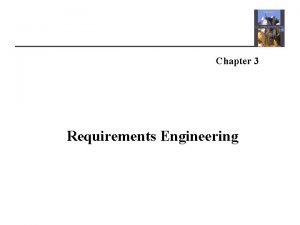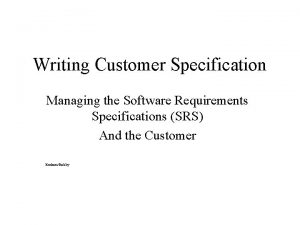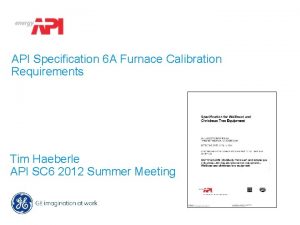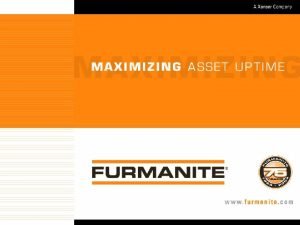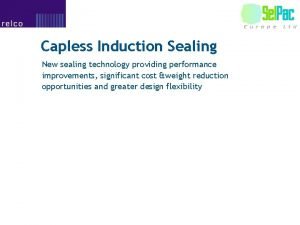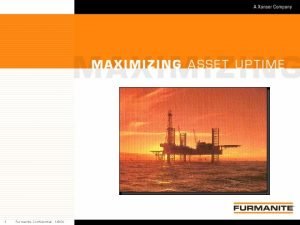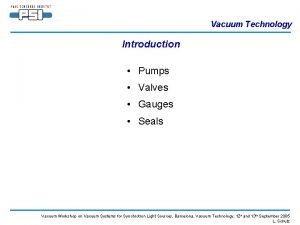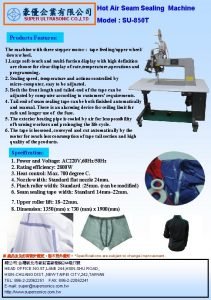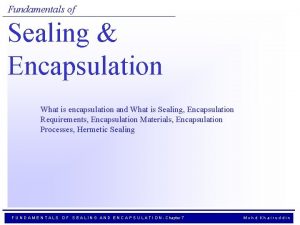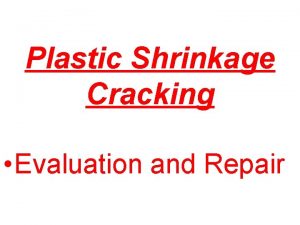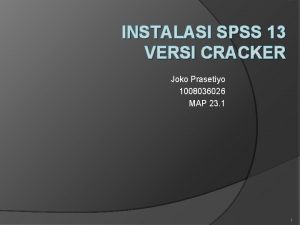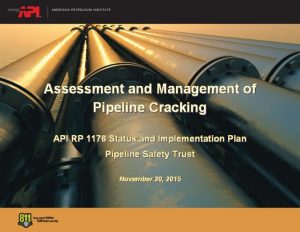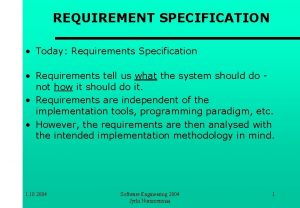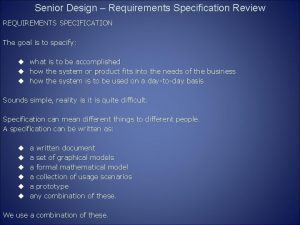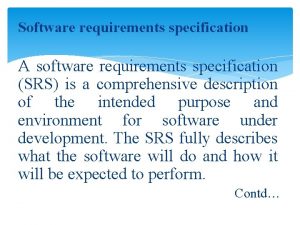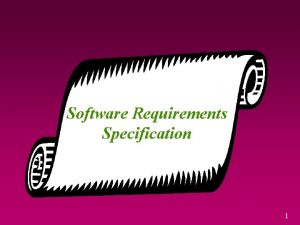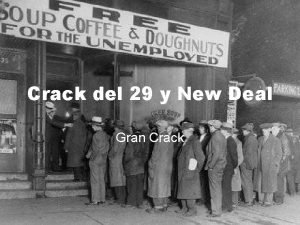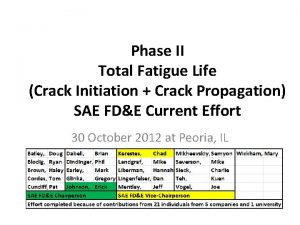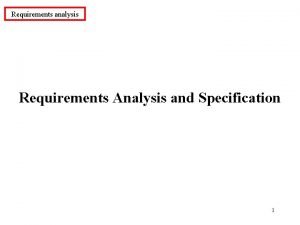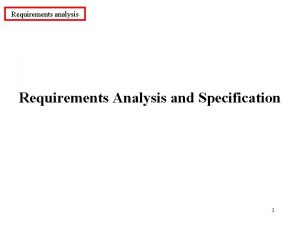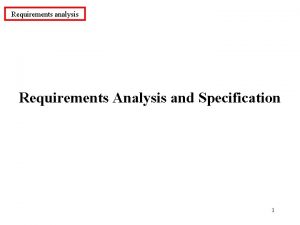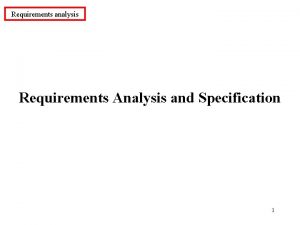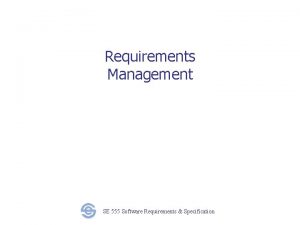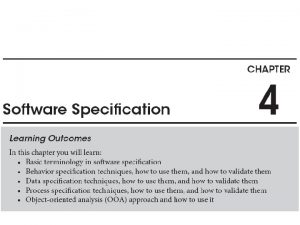Understanding Crack Sealing Materials and Specification Requirements Prepared






































- Slides: 38

Understanding Crack Sealing Materials and Specification Requirements Prepared for 36 th Annual Rocky Mountain Asphalt Conference and Equipment Show Denver, Colorado Friday, February 20, 2009 Presented by: Vern Thompson Crafco, Inc. www. crafco. com Mark Schonack DISSCO markschonack@dissco. net

Topic Contents I. II. IV. V. VII. History of Sealing Cracks in Asphaltic Concrete Pavements Definitions/Crack Treatments Product Selection Bid Specification Inserts Summary for Successful Program Remember Thank You!

I. History of Materials for Sealing Cracks in A. C. Pavements n From the beginning through 1970 +/q q n 1975 through today q n Development of a modified asphalt and crumb rubber 1980 through today q n Minimal if any crack sealing Virtually placing anything and/or everything in cracks to fill the void, ie straight asphalt, cutbacks, emulsions, etc. Superior performing sealants developed with asphalt, polymers, plasticizer, etc. Today q Ongoing research and development for better performing AC crack sealant materials for asphaltic pavement cracks

II-A. Definition: Crack Treatments The process to apply a material into the asphalt pavement cracks to either crack-seal and/or crack-fill with the common goal to maintain or seal and performance within the pavement void section to prevent moisture and foreign particle intrusions.

II-A. Why Do Crack Treatments? ? n n n Prevents water intrusion into subbase Prevents incompressible intrusion Improves ride quality smoothness Slows down pavement deterioration COST EFFECTIVE

II-A. Why Do Crack Treatments? ? “Cracks are inevitable, and neglect leads to accelerated cracking and potholing, further reducing pavement serviceability. ” (FHWA-RD-99 -147)

II-A. Why Do Crack Treatments? ? Pavement preservation offers a ready solution that can put dollars back into the budget. “Preservation teaches us to fix it before it breaks. This philosophy when applied extends the service life and saves dollars. ” Jim Sorensen FHWA

II-A. Why Do Crack Treatments? ? For Prevention Of: Water Intrusion Pavement Failure Incompressible Intrusion

II-B. Definition: Crack Sealing Materials To seal pavement working cracks: “The placement of specialized treatment materials above or into working cracks using unique configurations to prevent the intrusion of water and incompressibles into the crack. ” (FHWA-RD-99 -147)

II-B. Crack Sealing What is a “working crack” 1. High movement (expansion/contraction and surface temperature related) 1. Typically minimum >1/8 inch (>3 mm) width 2. Typically maximum <2 inch (<50 mm) width 2. Crack type thermal (transverse) 3. Use of routed reservoir 4. Pavements in good condition >20 ft spacing and minor other cracking 5. Sealants that are flexible and extensible at lowest surface temperatures encountered

II-B. Crack Sealing Crack type - thermal • Route at least 1/8” from each crack face • Keep centered over crack • Reduce spalling by using as many cutters as possible and/or wide hub carbide cutters

II-B. Crack Sealing

II-C. Definition: Crack Filling Materials To fill, yet maintain seal for non-working cracks: “The placement of ordinary treatment materials into non-working cracks to substantially reduce infiltration of water and to reinforce the adjacent pavement. ” (FHWA-RD-99 -147)

II-C. Crack Filling What is a non-working crack 1. Low or “no” movement 1. Typically minimum >1/8 inch (3 mm) width 2. Typically maximum < 2 inch (50 mm) width 2. Crack Type: longitudinal, block, thermal (crack spacing <20 ft spacing) 3. In wheel paths and high traffic areas 4. Stiffer, more traffic resistant product 5. Routed or non-routed reservoirs (use discretion), overband applications 6. Pavements in fair to poor condition

II-C. Crack Filling Crack type – Longitudinal & Close Thermal Spacing

III-A. Product Selection A. For Performance Crack Sealing Applications n Rubberized and polymer modified asphalt sealants -in routed cracks anticipate 5 -9 years performance n Rubberized and polymer modified asphalt sealants -in non-routed cracks anticipate 2. 5 -5 years performance (Performance defined as > 98% effectiveness) Crack Filling Applications n Emulsion and asphalt cement fillers in unrouted cracks anticipate 1 -3 years performance n Rubber and modified asphalt fillers -in unrouted cracks anticipate 3 -5 years -in routed cracks anticipate 4 -7 years -

III-B. Product Selection B. For Performance & Climatic Conditions This process of our sealant selection is determined by the FHWA paving asphalt research program, the project known as LTPP (long term pavement performance) with the goal of improving pavement design, pavement performance and pavement preservation processes. The same data process (high and low pavement temperature readings) has been applied to determine sealant selections to be used in pavement preservation treatments. The maps are noted with the color code per geographic location for high and low pavement temperatures determine the temperature scale (in Celsius). Matching the high and low recorded temperatures to the proper coded temperature scale will aid you to select the proper sealant with a 98% confidence to provide highly reliable results.

III-C. Product Selection LTPP Temperature Recorded Maps Surface Temperature

III-C. Product Selection LTPP Temperature Recorded Maps Surface Temperature

III-C. Product Selection – Usage Guideline Sealant recommendations per pavement temperature grade charts (example shown is for particular type sealant selection only) Pavement Temp for Sealant Usage Temperature performance limits: Crack Sealant 64 -28 Pavement Temp for Filler Usage Crack Filler 64 -34

III-D. Product Selection Determine Installation geometry to accommodate expected movements and related performance. 1. Crack Configuration Routed Configuration Non-Routed Configuration Life cycle costs show that by utilizing either configuration A, B or C, the cost of crack treatments is 50% less than that of using configuration D or E.

III-D. Product Selection 2. Crack Movement

III-E. Product Selection Typical Sealant Specification Required by End User Black/hot/sticky/fill void specification (minimal requirements) An agency “home brew” specification A. B. C. (ASTM) American Society for Testing Materials spec C. A. B. C. D. E. A. F. ASTM D 5078 ASTM D 6690 Type I (formerly ASTM D 1190) ASTM D 6690 Type II (formerly ASTM D 3405) ASTM D 6690 Type III (formerly ASTM D 55 -5 -1401 C) ASTM D 6690 Tyler IV (formerly ASTM D 3405 -low modulus) (AASHTO) American Association of State Highway & Transportation Officials spec D. E. Take various test requirements from multiple specifications to establish an original written un-proven specification. End results specification no supplier can supply Highly unlikely end performance achieved AASHTO M 324 (formerly AASHTO M 173 & M 301) Federal Specification SS-S-_ _ _ Manufacturer’s Specification

III-F. Product Selection Explanation of Sealant Test Parameters per Stated Specification (as noted previously) Terms Related to Hot Applied Sealant Properties Used in Testing Specified Sealant Materials Asphalt Compatibility (Condition) – This evaluation indicates if there is a compatibility problem which exists between the sealant being used and the asphalt concrete pavement itself. All asphalt based sealants should pass the test. Bond Testing (Cold Climate) evaluates the ability of a material to remain adhered to concrete test blocks when extended multiple times. The temperature, number of cycles, block conditions, specimen size and extension % can vary with the spec and grade of material tested. Failure generally shows up as adhesive or cohesive separations in the specimen when extended. (ASTM D 6690 Type I, III, IV, D 5329)

III-F. Product Selection Brookfield Viscosity (flow/thick/thin) measures the rotational viscosity of a liquid material. Ductility (cold climate) measures the amount of extension a material will take at a specific temperature and rate. Indicates lower temperature elongation characteristics and relative material stiffness. Flow (warm to hot climates) – This test indicates high temperature flow resistance of a material and the ability to resist flowing from a crack or joint at high summer temperatures of 140° or 158 °F. Needle Penetration (hot & cold climate) – This is the standard penetration test for asphalts or homogeneous materials. The test indicates the hardness of an asphalt or sealant at a specific temperature by measuring the amount of penetration of a standard needle with a specific weight.

III-F. Product Selection Resilience (measure of strength or weakness) – This is a measure of elastic rebound of a material at 77°F. Higher resilience means increased elasticity and strength of the material. Higher resilience materials may be more difficult to obtain good adhesion because high elasticity tends to promote adhesive separations when the sealant is extended. Softening Point (warm to hot climate) – This is a basic indication of the temperature at which a material changes from a solid to a viscous liquid. The sealant is more resistant to tracking the higher the softening point. Tensile Adhesion (cold climate) – This measures the amount of elongation that a sealant can take. Higher results indicate greater elongation capabilities of the sealant. Specific Gravity (weight) – Measures the unit weight. Example: 1. 1 specific gravity x 8. 33 = 9. 2 lbs/gal

IV. Bid Specifications Should consider as additional inserts to your bid solicitation 1. 2. 3. 4. The (Agency) reserves the right to reject any or all bids, wholly or in part, to waive any technicality in any bid, to make awards in a manner deemed in the best interest of the Agency. Low price is not necessarily the determining factor for acceptance. Bid prices will be firm for the duration period of the contract, ie 30 days, 90 days, 6 months, 1 year. Pricing review each ninety (90) day period for price escalation or de-escalation subject to agency approval. Contract subject to 30 days cancellation by either party upon written notice of cause. (Agency), , with agreement of the supplier, may extend the contract up to “X” additional years in one year increments. Payment will be made based on the net pallet weight per pound.

IV. Bid Specifications 5. 6. 7. 8. The joint seal shall contain no solvents and shall cure upon cooling to consistency that will not track by traffic. The joint seal shall be suitable for melting and applying with the conventional melter-application units in the (Agency) equipment fleet or use by the contractor. Joint seal material found to cause application problems or found to result in unsafe conditions prior to or during use will be just cause to cancel the existing contract immediately and the supplier will be responsible for the removal of any remaining sealant stored on Agency property. Sealant meeting the (Agency) specification as described shall have been placed at “X” different locations within the (Agency) area. This listing with “X” years performance at each location shall be submitted with the bid solicitation. The (Agency) reserves the right to have the material tested by a private laboratory prior to bid award.

IV. Bid Specifications 9. 10. 11. 12. The (Agency) reserves the right at any time during the contract to sample sealant delivered but prior to the placement and have a designated independent laboratory test the sealant for specification conformance. Additionally with non-complying sealant reported by either the agency and/or independent laboratory results, the agency has the right to cancel the existing contract immediately and the supplier will be responsible to remove any sealant that is located on the agency’s property and subject to price penalties. Sealant boxes shall be manufactured from double wall board producing a minimum bursting test certification of 350 PSI (241 N/cm 2) and water resistant adhesives. Palletized units shall be protected from weather by using a three (3) mil plastic bag weather and moisture resistant white in color (not transparent) cap sheet and a minimum of two (2) layers of six (6) month U. V. protected stretch wrap.

IV. Bid Specifications Each pallet shall contain a copy of the sealant Installation Instructions enclosed in a weather resistant enclosure. 14. Each sealant box container shall be labeled for easy visual identification (application & safe heating temperature, lot/batch/ID information, safety information) 15. Manufacturer shall supply a detailed safety instruction manual. 16. Minimum of one (1) year review of sealant performance will be conducted by the supplier and agency prior to the following years request for bids. If it is determined that the provided product is not performing to acceptable standards, the material and possibly the supplier will not be considered for future bidding Note: Agency “must” follow through with implementation of noted data for a successful crack treatment program. 13.

V. Summary for Success with a Crack Sealant Program 1. 2. 3. 4. Pavement condition must be appropriate for crack treatment Treatment must be designed for conditions Sealant properties must be matched to the climate Evaluate pavement for applicability and for treatment type – seal or fill

V. Summary for Success with a Crack Sealant Program 5. 6. 7. 8. Reservoirs required for moving cracks Select sealant for temperature extremes and movements, verify properties Determine installation geometry to accommodate expected movements Install correctly, clean, dry, temperatures

V. Summary for Success with a Crack Sealant Program 9. 10. 11. 12. Quality control of the entire process Agency follow through inspection imperative with contractor installation Crack treatments widely used Agencies that have studied and designed the process for their conditions (climate, pavement) having the most success.

VI. Remember Per the Pavement Preservation Process Always The “Right Product” The “Right Pavement” The “Right Time” Equals = A Successful Long Term Program

VI. Remember A successful crack treatment program Pavement – clean, dry, routed, proper application Application – Flush with pavement “No” potential bump Note: Safety Apparel

VI. Remember Incorrect Preparation Adhesive Separation Incorrect Sealant Selection Cohesive Separation

VI. Remember “Without” a successful crack treatment program Results =

VII. Thank You Vern Thompson www. crafco. com Mark Schonack DISSCO markschonack@dissco. net
 If lclp is negative number, we set the lclp = 0. why?
If lclp is negative number, we set the lclp = 0. why? Natural variations operations management
Natural variations operations management Software
Software Volere requirements specification template
Volere requirements specification template System requirements specification
System requirements specification What is customer specification
What is customer specification Volere requirements specification template
Volere requirements specification template Api requirements specification
Api requirements specification Ambulance dispatch system requirements specification
Ambulance dispatch system requirements specification Furmanite leak sealing
Furmanite leak sealing Capless sealing
Capless sealing Homophones for leek
Homophones for leek Furmanite clamp
Furmanite clamp Pump of the volume
Pump of the volume Ultrasonic seam sealing machine
Ultrasonic seam sealing machine Telecommunication sealing technology
Telecommunication sealing technology Hondron
Hondron Underfilling encapsulation protection solutions
Underfilling encapsulation protection solutions Telecommunication sealing technology
Telecommunication sealing technology Alcatel lucent
Alcatel lucent Natural materials and man made materials
Natural materials and man made materials What is useful and harmful materials
What is useful and harmful materials Man made map
Man made map Adopting and adapting teaching materials
Adopting and adapting teaching materials The world of food and beverages chapter 4
The world of food and beverages chapter 4 Ideal properties of restorative material
Ideal properties of restorative material Direct materials budget with multiple materials
Direct materials budget with multiple materials Epistrophe
Epistrophe Why is carcase meat prepared into cuts joints and mince
Why is carcase meat prepared into cuts joints and mince The accepted standard of sound and rhythm is
The accepted standard of sound and rhythm is Sharon milgram
Sharon milgram Are there ethical reasons to try to crack secret codes?
Are there ethical reasons to try to crack secret codes? Act crack english
Act crack english Plastic shrinkage cracking repair
Plastic shrinkage cracking repair Download spss 13 full crack
Download spss 13 full crack Lopht crack
Lopht crack Precordial catch syndrome
Precordial catch syndrome Pipeline crack management
Pipeline crack management Convergent continental boundary
Convergent continental boundary




